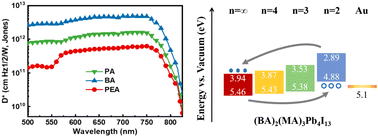Molecular engineering for sensitive, fast and stable quasi-two-dimensional perovskite photodetectors†
Abstract
Perovskite photodetectors have excellent photodetection properties in the visible range, but the operation stability of the related devices is still questionable for next-stage commercialization. In this work, a series of representative structurally-related ammonium salts is selected to form solution-processed Ruddlesden–Popper (RP) quasi-two-dimensional (quasi-2D) perovskite photodetectors. We find that the stacking distribution and crystallinity of the low-dimensional components can be effectively tuned with the phenyl and alkyl structures as well as the chain length, so as to significantly affect the photo-sensing abilities. With the optimal butylamine (BA) spacer, a high-quality quasi-2D perovskite film featuring a well-aligned energy cascade is realized to facilitate charge separation as well as photoconductive gain, resulting in a record high detectivity of 5 × 1012 Jones, a fast rise/fall time of 3.6/35 μs and prolonged ambient and operational stability. The stability analysis indicates that the dark current level increment is the essential feature to affect the reliability of perovskite photodetectors, and it can be well-suppressed by quasi-2D components that can restrain the ion-migration doping. This work opens a pathway to high sensitivity and stable perovskite photodetectors, as well as to understanding the degradation mechanism in photodetection devices.

- This article is part of the themed collections: #MyFirstJMCC and Stability of Optoelectronic Materials and Devices


 Please wait while we load your content...
Please wait while we load your content...